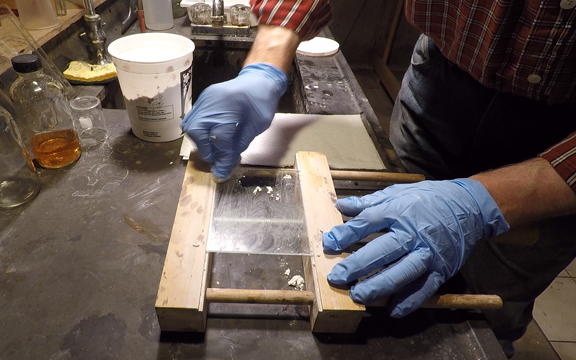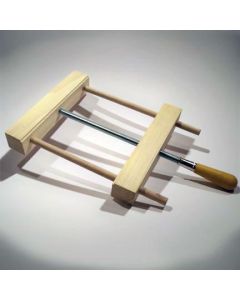Preparing Glass Plates for Collodion

Plate Prep for Glass
Plates of various colors can be purchased from a variety of stained glass outlets. When purchasing glass, be sure to ask for "Float" glass. Unlike much of the glass used in stained glass applications, float glass has a smooth surface.
For starters, and to keep things simple, you can also purchase ordinary plate glass at your local hardware store to make your images. This will be available in a variety of thicknesses. The thickness of the glass is not important, as long as you can fit it into your plate holder and still close the darkslide or door.
Once you have it cut to properly fit your plate holder, be sure to sand or "file" the edges. For this, one can use sandpaper or more conveniently, a sharpening stone. Both serve the same purpose, but the sharpening stone will last forever, is easier to handle, and is less messy. Keep the sharpening stone or sandpaper wet while filing the edges of the plate. This keeps the glass dust from blowing around in the air, getting on everything else, and being inhaled. Gently file all edges (both sides) of the glass plate to remove the edges that might "bite" you later. Be careful not to strike the plate with the sharpening stone as this might chip the glass or crack it. The purpose of filing the edges serves two purposes. First, it will make it less likely that you'll accidentally cut yourself later on, and secondly, it helps keep the collodion away from the very edge of the plate which helps prevent the collodion from catching and peeling.
When you've smoothed all the edges, wipe them down with a cloth or rinse the palte with water to get rid of the excess glass dust. Place the plate in a wooden vise, tighten the vise just enough to firmly hold the plate, and then pour a thick slurry of whiting (calcium carbonate) and water onto the surface of the glass. You can also use alcohol in place of water if you need it to dry faster.
Use a clean cloth or paper towel to vigorously scrub the surface of the plate with the whiting slurry. Press firmly and scrub in small circular motions, covering the entire plate. Pay particular attention to the edges, they often get over looked and get less scrubbing time than the center of the plate. Continue to scrub for a couple of minutes. Wipe the surface dry with a clean dry cloth. Flip the plate over and repeat on the opposite side.
When done, remove the plate from the vise and wipe down the edges of the glass to remove any excess whiting that may have collected there (this keeps the chalk dust from contaminating your silver nitrate bath later on). Before moving on to the next step (which is coating the plate), make sure your camera is set up, your shot composed, and your exposure calculated. Once the collodion is poured on the plate, you have a limited amount of time with which to work before the collodion dries out and is no longer usable. The practical working time depends on the temperature and humidity of the day. Generally, 75 F degrees and 40% humidity will give you approximately 5 or 10 minutes of working time. Experience will tell you how long you have to work under the conditions in your area.

